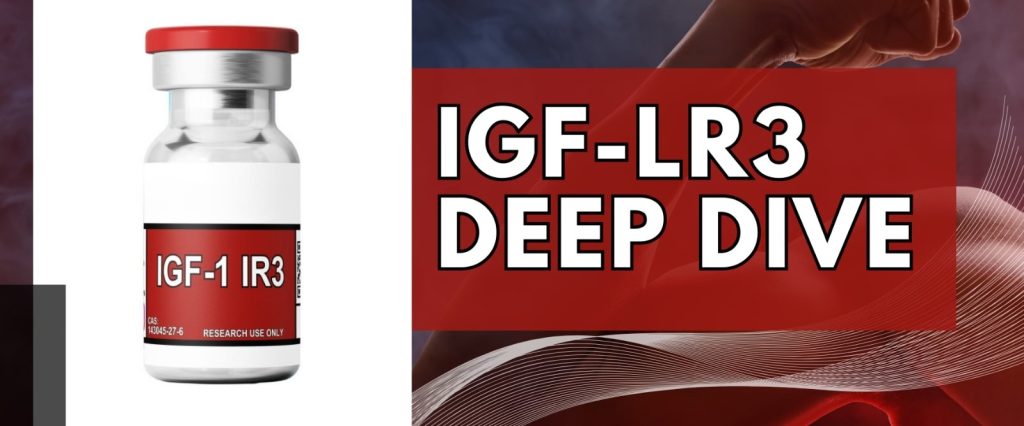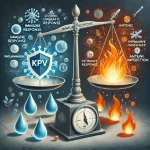In this article we will dive into
- What is IGF-LR3
- History of IGF-LR3
- How It Works In the Body
- Benefits of IGF-LR3
- Side Effects of IGF-LR3
- My Experience with IGF-LR3
- Growth Hormone vs IGF-LR3
And more!
What is IGF-LR3
Insulin-like Growth Factor 1 Long R3 (IGF-1 LR3) is a synthetic peptide that is an extended and modified version of the naturally occurring hormone IGF-1. IGF-1 is a protein hormone similar in molecular structure to insulin, and it plays a crucial role in childhood growth and continues to have anabolic effects in adults.
The modification in IGF-1 LR3 extends its half-life and enhances its stability and potency compared to natural IGF-1.
While IGF-LR3 has tons of benefits, this article will be primarily focusing on the bodybuilding related benefits of IGF-LR3 in terms of weight loss and muscle building.
History of IGF-LR3
The role of IGF-1 in growth and development was first identified in the 1950s. IGF-1 LR3 was developed later as researchers sought to create a more potent and longer-lasting version of IGF-1 for medical and research purposes.
The modification, which involves replacing the glutamic acid at position 3 with an arginine and adding a 13-amino acid extension, significantly increases the half-life of the peptide, allowing it to remain active in the bloodstream for longer periods.
This modification essentially created a more powerful version of IGF-1 that could be leveraged to aid in helping the various conditions that IGF is typically prescribed for.
How It Works In the Body
IGF-1 LR3 functions by binding to IGF-1 receptors on cells, triggering a series of intracellular signaling pathways. IGF-1 is involved in hundreds of different functions and processes in the body but in this article we will focus on these key topics.
This interaction promotes cellular growth, differentiation, and survival. Here’s a breakdown of its key functions:
Muscle Growth: IGF-1 LR3 enhances muscle protein synthesis and prevents muscle degradation. It stimulates the proliferation and differentiation of myoblasts (muscle precursor cells), leading to muscle hypertrophy.
Cellular Repair and Regeneration: By promoting cell growth and survival, IGF-1 LR3 aids in the repair of damaged tissues. This property makes it beneficial for recovery from injuries.
Fat Metabolism: IGF-1 LR3 can increase fat metabolism, making it a valuable tool for those looking to reduce body fat while maintaining muscle mass.
Bone Density: It supports bone growth and density, which can be beneficial in preventing conditions like osteoporosis.
Benefits of IGF-LR3
IGF-LR3 has some very powerful benefits.
Enhanced Muscle Growth
Due to its anabolic properties, IGF-1 LR3 is popular among bodybuilders and athletes for its ability to significantly increase muscle mass.
IGF-LR3 is able to not only Enhance Muscle Growth, but also help build new muscle cells through a process known as hyperplasia.
This combination of both growth and the creation of new cells makes it an insanely powerful muscle builder.
Improved Recovery
Its role in cellular repair and regeneration makes it effective in enhancing recovery from injuries and intense physical activity.
IGF-LR3 is great for overall recovery from day to day workouts and training, but also for injuries.
LR3 will help to speed up the healing process for various joint and tendon based issues.
Fat Loss
By boosting fat metabolism, IGF-1 LR3 helps in reducing body fat while preserving lean muscle mass.
Many people do not expect this as they typically just see it for growing muscle but it does help to promote weight loss pretty effectively.
Many people are surprised at the weight loss they experience with this compound, as it gives a really effective recomp effect.
Anti-Aging
Some studies suggest that IGF-1 LR3 may have anti-aging effects due to its ability to promote cellular regeneration and repair.
It also can help to improve skin, hair and nail health.
You will notice faster hair growth, better skin health, and better nail health when using this product.
Decreased Myostatin
In certain mouse models IGF-LR3 has been shown to counteract myostatin and decrease this catabolic muscle protein.
Myostatin is the body’s way of regulating muscle mass so that you do not grow too large. So of course by lowering this protein you will be able to unlock even more muscle building capabilities.
Reduced Side Effects with Glucocorticoid Signaling
Glucocorticoids tend to have side effects like muscle wasting and the increase of body fat.
IGF-LR3 works against these to help ensure you are not wasting muscle and you are staying nice and lean.
Side Effects of IGF-LR3
While IGF-1 LR3 has numerous benefits, it also comes with potential side effects, especially when used improperly:
Hypoglycemia: As IGF-1 influences insulin activity, it can lead to low blood sugar levels if not monitored properly.
Organ Growth: Prolonged use of IGF-1 LR3 can potentially cause abnormal growth of organs due to its potent growth-promoting effects.
Joint Pain: Some users report joint pain, possibly due to rapid muscle growth and increased physical activity.
Carpal Tunnel Syndrome: Overuse can lead to symptoms of carpal tunnel syndrome, likely due to tissue swelling.
Speeds Up Cancer Growth: One of the most significant side effects associated with IGF-LR3 is the fact that it can theoretically speed up the rate at which existing cancer can grow and while it does not cause cancer this increase in growth can of course be problematic.
My Experience with IGF-LR3
For me IGF-LR3 was insane. I was having some of the most crazy pumps and noticed that every single day my physique was changing greatly.
I was quickly packing on tons of size and muscle mass while also looking leaner and more vascular.
I also noticed that when I was on this compound my hair was growing much faster and my skin looked amazing.
All in all I loved being on this compound as it gave me some insane gains, increased pumps, I lost body fat, and my hair and skin looked awesome.
Check also about AC-262 Vs Ostarine: Sarm Battle (Which Sarm Is The Best For You!
Online Experiences with IGF-LR3
Here are some anonymous experiences pulled from the online community reddit.
Growth Hormone vs IGF-LR3
A common question revolves around how this compound compares to growth hormones. This is how they compare.
Growth Hormone (GH) and IGF-1 LR3 are often compared due to their similar roles in promoting growth and regeneration. Here’s how they stack up against each other:
Mechanism of Action: GH stimulates the liver to produce IGF-1, which in turn mediates many of GH’s growth-promoting effects. IGF-1 LR3 acts directly on cells, bypassing the liver.
Potency: IGF-1 LR3 is more potent and has a longer half-life than natural IGF-1, making it more effective in smaller doses.
Side Effects: GH has a broader range of side effects, including potential issues with glucose metabolism, while IGF-1 LR3’s side effects are primarily related to its direct growth-promoting effects.
Usage: IGF-1 LR3 is preferred for targeted muscle growth and recovery, whereas GH is often used for its systemic effects on growth and metabolism.
IGF-LR3 Dosing
IGF-LR3 dosing can range quite alot.
Beginner Dosing is anywhere from 25-50mcg
Intermediate Dosing clocks In at around 50-100 mcg
Advanced Dosing In my opinion is from 150 mcg and anything above
Dosing should be done daily and can be done pre or post workout. The time you use it is less important then something like IGF-DES as the long half life means it will be effective nearly all day for you.
Some advanced dosing protocols combine IGF-LR3 with Growth hormone and with Insulin to potentiate the power.
Typical cycles go anywhere from 3-6 weeks. You do not want to go more than 6 weeks as the power of this compound is very strong.
Conclusion
In conclusion IGF-LR3 is one of the most powerful muscle builders and physique builders around.
This is an extremely advanced compound that can change your physique in an amazing way very fast.
After reading this article though you should have all the tools you need to have a great experience using IGF-LR3!
Works Cited
- Bartke A, Chandrashekar V, Dominici F, Turyn D, Kinney B, Steger R, Kopchick JJ. Insulin-like growth factor 1 (IGF-1) and aging: controversies and new insights. Biogerontology. 2003;4(1):1-8. doi: 10.1023/a:1022448532248. PMID: 12652183.
- https://joe.bioscientifica.com/view/journals/joe/234/2/JOE-17-0032.xml#:~:text=Abstract-,Insulin%2Dlike%20growth%20factors%20(IGFs)%20and%20myostatin%20have%20opposing,%2C%20and%20myostatin%20inhibiting%2C%20growth.
- Adams GR. Insulin-like growth factor in muscle growth and its potential abuse by athletes. West J Med. 2001 Jul;175(1):7–9. PMCID: PMC1071449.
- https://www.ncbi.nlm.nih.gov/pmc/articles/PMC4937435/







